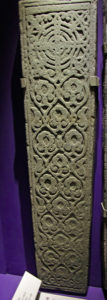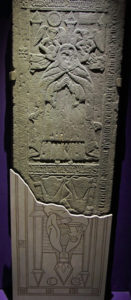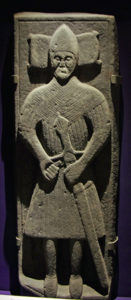By the 700s, Iona was peppered with both wood and stone crosses. It is thought these could have marked sites associated with miraculous events in St Columba’s life. They became stations on the pilgrim route where pilgrims would pause and pray before arriving at St Columba’s shrine. Most were lost during the Reformation, but some survived and are displayed in the museum attached to Iona Abbey.
Housed in the monastery Infirmary is one of the finest collections of carved crosses, slabs and grave markers in Britain. They include stone crosses placed around the island as prayer stations for pilgrims as well as grave slabs from Reilhig Odhrain.
On entering the Museum the first impression is of the three massive “High Crosses”:http://wasleys.org.uk/eleanor/churches/scotland/highland/iona_abbey/abbey_six/index.html which dominate the space. In the centre is ST JOHN’S CROSS, dating from around 700 and was the first of the ring crosses. Now much broken this used to stand in front of the Abbey Church, where a replica now stands. It is covered with complex patterns and bosses. The three ‘eggs’ inside the circular bosses represent the Trinity. The groups of five bosses represent the five wounds suffered by Christ on the Cross. The lozenges on the shaft are symbols of divinity. The only animals are lions (symbolic of Christ’s Majesty) and snakes (representing wisdom and resurrection).
To the left is ST ORAN’S CROSS, which is slightly older. This stood near St Oran’s chapel and again this has been broken and is held together by a special steel structure. Just below the cross arm is an image of the Virgin and Child surrounded by angels. On the cross arm is Daniel in the lion’s den. The shaft is covered withsnakes and bosses.
To the right of St John’s Cross is ST MATTHEW’S CROSS, dating from around 900. This stood outside the Abbey church and the base holding it is still there. The cross was carved from poorer quality stone and only the cross shaft and part of one of the cross arms survive. Adam and Eve in the garden of Eden with the serpent coiled round the tree can just be made out on the shaft base.
There is one other cross dating from 900 displayed on a side wall. This is quite crude in comparison to the High Crosses with just a solid disc shaped head. It resembles crosses found at an early monastery on the Isle of Bute.
The shaft of MACKINNON’S CROSS dates from 1489. The inscription reads “This is the cross of Lachland MacKinnion and his son John, Abbot of Iona, made in the year of Our Lord, 1489.” Beneath it is a sailing galley. On the opposite side is a design of loops and foliage emanating from the tail of a griffin.
The rest of the display consists of “grave slabs”:http://wasleys.org.uk/eleanor/churches/scotland/highland/iona_abbey/abbey_seven/index.html from the C7th to C16th. The earliest is the STONE OF ECHODI which was carved a few years after the death of St Columba at the end of the C7th. Along with other early grave markers it just has a simple cross carved on it.
Later grave markers from the C10th have crosses with intersecting knots, pleats and loops. The two markers from the nunnery are particularly beautiful.
There are five “West highland Grave Slabs”:http://wasleys.org.uk/eleanor/churches/scotland/highland/iona_abbey/abbey_eight/index.html in the Museum dating from 1300-1500 and all come from Reilig Odhrain. The warriors were part of a professional fighting force available to fight anywhere, anytime and for anyone who would pay them. Hebridean chiefs could regularly muster a force of 6000-7000 men. They were often landless and unmarried. Their expensive and elaborate grave slabs were their way of leaving their mark on the world. They are all clad in clothing designed to cope with the harsh weather with a padded coat made of leather and stuffed with wool or straw and waterproofed with grease. They wore a mailed hood over the shoulders and a conical steel helmet. Although they each have a sword, their chief weapons were probably axes, bows or spears.
I loved the museum and spent a lot of time looking and photographing the crosses and carved stones. It is a remarkable collection and worth allocating plenty of time to visit.
There is a lot more information and pictures of Iona Abbey “here.”:http://wasleys.org.uk/eleanor/churches/scotland/highland/iona_abbey/index.html










